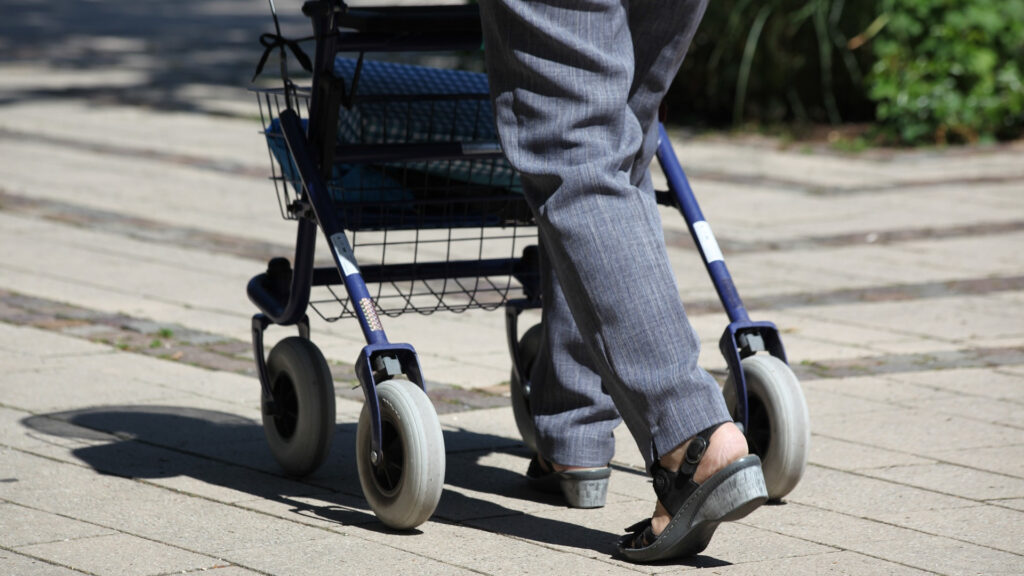Walking difficulties are a common and challenging symptom for individuals living with Parkinson’s disease. These issues can significantly impact daily activities and overall quality of life. This article explains the reasons why Parkinson’s patients may struggle with normal walking, and provides insights into the complexities of this neurodegenerative disorder.

Walking normally involves a complex interplay of neurological, muscular, and sensory systems. All of these can be affected by Parkinson’s disease. Many individuals with Parkinson’s experience changes in their walking ability. These changes not only challenge mobility but can also affect independence and quality of life. Understanding the underlying causes of these walking difficulties is crucial for managing symptoms and finding effective treatments.
Here are the five reasons why Parkinson’s patients might not be able to walk normally.
1. Bradykinesia
One of the primary reasons Parkinson’s patients struggle with walking is bradykinesia. This term is derived from a Greek word that means slowness of movement. This symptom is a hallmark of Parkinson’s disease and affects every aspect of motion.
Bradykinesia can make it difficult to start walking, and once moving, patients often have trouble maintaining a steady pace. The steps might become shorter, turning walking into a slow shuffle. This reduction in speed and step length can significantly disrupt the ability to walk normally. Additionally, the lack of quick, spontaneous movement can make it hard to adjust the walking pattern in response to changes in the environment, further complicating mobility.
2. Muscle rigidity
Muscle rigidity, or stiffness, is another common symptom of Parkinson’s that interferes with normal walking. The rigidity primarily affects the limbs and trunk. It makes movements stiff and jerky rather than smooth. This stiffness can hinder the natural swing of the arms and legs while walking, leading to a rigid, uncomfortable gait that lacks fluidity and range of motion. Over time, the constant muscle tension can lead to fatigue, exacerbating difficulties with walking and daily activities requiring mobility.
3. Postural instability
Postural instability refers to impaired balance. This problem is common in Parkinson’s patients and is considered a major factor that complicates normal walking in Parkinson’s patients. This instability makes it hard to maintain an upright position, and patients may lean forward or backward unintentionally. Such balance issues increase the risk of falls and contribute to the difficulty of achieving a normal walking pattern. The lack of stability can also make it challenging for patients to navigate uneven surfaces or steps, leading to a greater reliance on assistive devices like canes or walkers.
4. Freezing of gait
Freezing of gait is a phenomenon that many Parkinson’s patients experience. During this condition, they suddenly find themselves unable to move forward, feeling as though their feet are glued to the floor. These episodes can last a few seconds to several minutes and often occur at the start of a walk, when turning, or when crossing a threshold.
This unpredictable symptom can disrupt the rhythm necessary for normal walking and can be particularly frustrating and dangerous for patients. Recovery from a freezing episode often requires external cues or changes in the pattern of movement, such as stepping over an imaginary line or changing direction.
5. Impaired reflexes
Walking normally requires complex coordination between various muscle groups and the nervous system. In Parkinson’s disease, the brain’s ability to communicate effectively with the muscles through nerves is impaired. This affects automatic motor skills, including the reflexes necessary for quick adjustments during walking. Without these reflexes, normal walking is challenging as the body cannot adapt quickly to changes in terrain or speed. The slow reaction time not only affects walking but also makes it difficult to respond effectively to potential tripping hazards, increasing the risk of injury.
Conclusion
The inability of Parkinson’s patients to walk normally stems from a combination of bradykinesia, muscle rigidity, postural instability, freezing of gait, and impaired reflexes. Each of these symptoms alone can disrupt walking, but often, patients experience several of them together. Understanding these factors is crucial for managing mobility issues in Parkinson’s disease and can guide therapeutic strategies aimed at improving gait and balance.